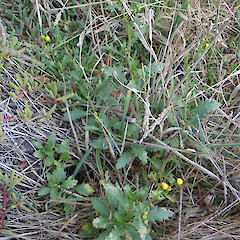Senecio matatini subsp. basinudus
Synonyms
Senecio lautus var. α raoulii Hook.f., Senecio glaucophyllus subsp. raoulii (Hook.f.) Ornduff, Senecio glaucophyllus subsp. basinudus Ornduff
Family
Asteraceae
Flora category
Vascular – Native
Endemic taxon
Yes
Endemic genus
No
Endemic family
No
Structural class
Herbs - Dicotyledonous composites
NVS code
The National Vegetation Survey (NVS) Databank is a physical archive and electronic databank containing records of over 94,000 vegetation survey plots - including data from over 19,000 permanent plots. NVS maintains a standard set of species code abbreviations that correspond to standard scientific plant names from the Ngä Tipu o Aotearoa - New Zealand Plants database.
SENBAS
Chromosome number
2n = 100
Current conservation status
The conservation status of all known New Zealand vascular plant taxa at the rank of species and below were reassessed in 2017 using the New Zealand Threat Classification System (NZTCS) – more information about this can be found on the NZTCS website. This report includes a statistical summary and brief notes on changes since 2012 and replaces all previous NZTCS lists for vascular plants.
Please note, threat classifications are often suggested by authors when publications fall between NZTCS assessment periods – an interim threat classification status has not been assessed by the NZTCS panel.
- Conservation status of New Zealand indigenous vascular plants, 2017 . 2018. Peter J. de Lange, Jeremy R. Rolfe, John W. Barkla, Shannel P. Courtney, Paul D. Champion, Leon R. Perrie, Sarah M. Beadel, Kerry A. Ford, Ilse Breitwieser, Ines Schönberger, Rowan Hindmarsh-Walls, Peter B. Heenan and Kate Ladley. Department of Conservation. Source: NZTCS and licensed by DOC for reuse under the Creative Commons Attribution 4.0 International licence.
2017 | At Risk – Naturally Uncommon | Qualifiers: DP, RR
Previous conservation statuses
2012 | At Risk – Naturally Uncommon | Qualifiers: RR
2009 | At Risk – Naturally Uncommon
2004 | Range Restricted
Distribution
Endemic. New Zealand: South Island (Banks Peninsula to the Otago Peninsula).
Habitat
Coastal to lowland, usually on basalt to basaltic-andesite rocks. Favouring exposed cliff faces and associated talus, boulder field. Occasionally found on sand and sand dunes near cliff faces.
Detailed description
Erect, glabrous, dark green to glaucescent, perennial herb up to 0.9 × 1.0 m. Rootstock woody. Branches arising from base, mostly persistent, in some populatiosn dying back in winter. Stems sparingly to much branched, 0.10–1 m tall. Lower stem leaves more or less evenly spaced and sized; shortly petiolate, petiole broad and tapering; lamina 100–300 mm long, dark green to glaucescent above, oblanceolate, lanceolate to elliptic to narrow-elliptic to pinnatifid, very coarse-dentate or lobate; main segments 2–6 extending for much of length, tending to be smaller toward apex, deltoid to lanceolate, apex obtuse to acute, base auriculate, with auricles divided, semiamplexicaul. Mid stem leaves similar but often more deeply divided, up to 600 mm long. Upper stem leaves narrower and smaller, bases auriculate, auricles deeply lacerate or entire. Inflorescences Unit—subterminal to terminal, of (4)–6–(12) capitula arranged subcorymbosely, overtopping variable. Involucral bracts 4.3–5.0 mm long, linear to linear-lanceolate. Ray florets 10–16 or absent, when present ligules 2–3.5 × 1.6–1.8 mm, bright yellow, linear ovate, ovate to oblong. Disc 4–6 mm diameter. Cypsela 2.5–3.5 × 0.5–0.8 mm, dark brown to black-brown, narrowly elliptic to oblong-elliptic, slightly narrowed to or constricted below apex, base cuneate; ribs broad and rounded; grooves deep, u-shaped; hairs conspicuous, retrorse in 1–6 rows, confined to grooves. Pappus 4.5–6.5 mm long, white.
Similar taxa
A distinctive plant which, beyond the shared chromosome number (2n = 100), has little obvious resemblance to Senecio matatini subsp. matatini. S. matatini subsp. basinudus has narrower darker green to glaucescent leaves and fewer-flowered inflorescences with smaller capitula. The seeds are somewhat broader than subsp. matatini and notably more hairy. S. matatini subsp. basinudus is a basicole favouring basalt and basaltic-andesite volcanics. Plants considered to be it at Cape Campbell appear to be another, probably related but undescribed entity. They differ by their smaller size, more deeply lobed to pinnatifid leaves, and larger flowers.
Flowering
October–March
Flower colours
Yellow
Fruiting
December–May
Propagation technique
Easy from fresh seed and semi-hardwood cuttings. An attractive perennial for a sunny spot. Excellent for rock walls or rockeries and very good in a pot.
Threats
No apparent threats. A narrow-range endemic of limited geographic distribution.
Etymology
senecio: From the Latin senex ‘old man’ (probably referring to the bearded seeds)
matatini: Te reo Māori adjective for ‘complicated’ and both an adjective and noun for ‘composite’ and ‘complex’. It alludes to the complicated nature of the historical and current taxonomy of the Senecio glaucophyllus complex, and to the daisy family to which it belongs
Where To Buy
Not commercially available
Taxonomic notes
The Senecio glaucophyllus complex, of which S. matatini is one representitive, was revised by Liew et al. (2021). For more information on the group please refer to this paper (reference below).
Attribution
Fact Sheet prepared for NZPCN by P.J. de Lange 1 November 2008, modified by R Hindmarsh-Walls 6 Feb 2022. Description based on Ornduff (1960), Webb et al. (1988) supplemented by observations obtained from fresh specimens and herbarium material
References and further reading
Liew C-S, Courtney SP, de Lange PJ, Pelser PB. 2021. Taxonomic realignment of Senecio glaucophyllus (Asteraceae; Senecioneae) necessitates a new name for a widespread New Zealand species. New Zealand Journal of Botany 59(3): 376–396. https://doi.org/10.1080/0028825X.2020.1866030.
Ornduff R. 1960. An interpretation of the Senecio lautus complex in New Zealand. Transactions of the Royal Society of New Zealand 88: 63–77.
Webb CJ, Sykes WR, Garnock-Jones PJ. 1988. Flora of New Zealand, Volume IV. Naturalised Pteridophytes, Gymnosperms, Dicotyledons. Botany Division, Department of Scientific and Industrial Research, Christchurch, NZ. 1365 p.
NZPCN Fact Sheet citation
Please cite as: de Lange, P.J. (Year at time of access): Senecio matatini subsp. basinudus Fact Sheet (content continuously updated). New Zealand Plant Conservation Network. https://www.nzpcn.org.nz/flora/species/senecio-matatini-subsp-basinudus/ (Date website was queried)











